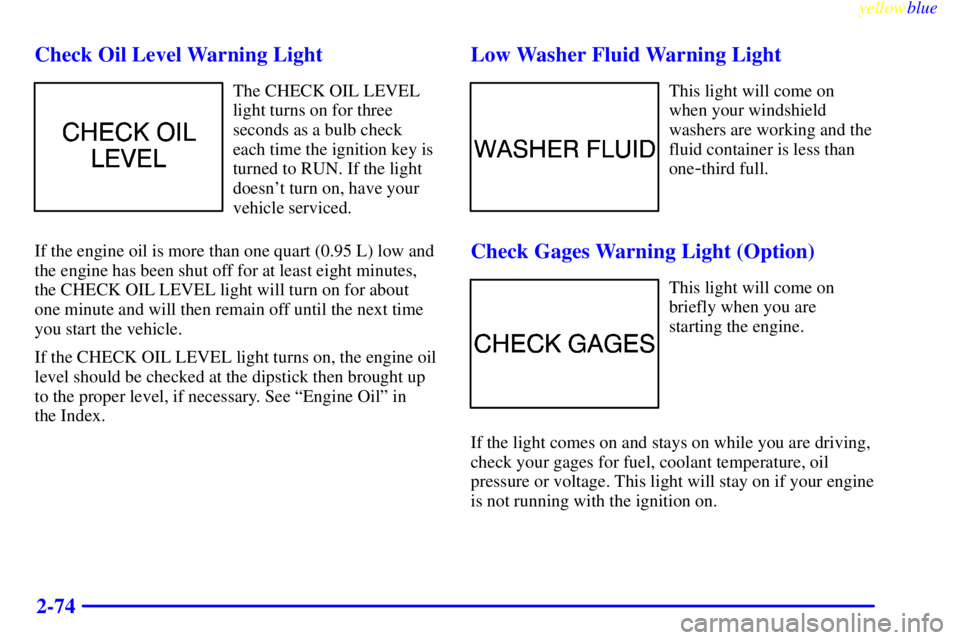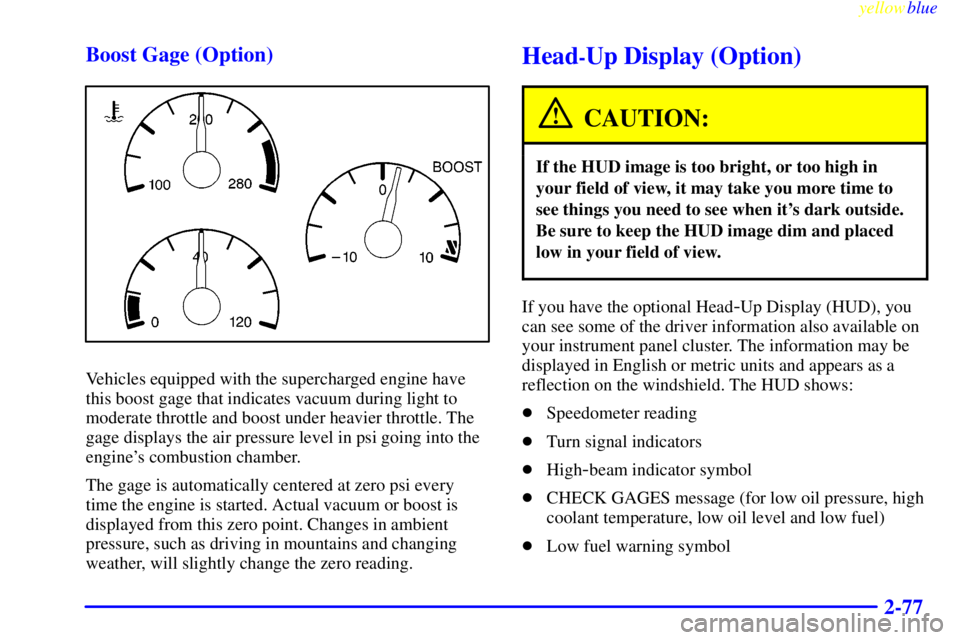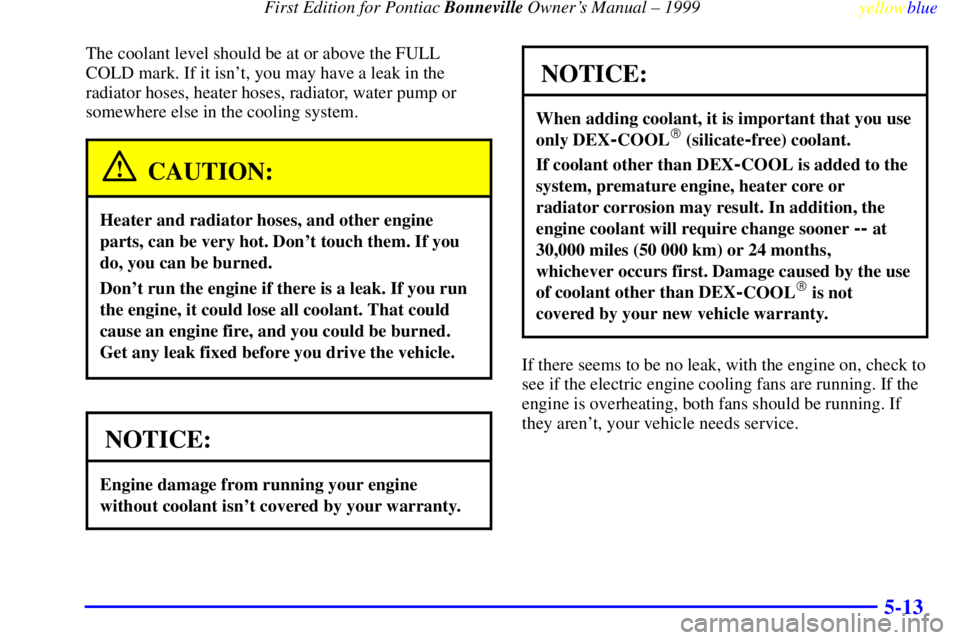Page 130 of 392

yellowblue
2-70 Low Coolant Warning Light (If Equipped)
If you have this light and it
comes on, your system may
be low on coolant and the
engine may overheat.
Check to see if the level is low at the recovery tank, and
add coolant if necessary. If the level is not low, have
your low coolant warning system serviced. See ªEngine
Coolantº in the Index.
The LOW COOLANT warning light will also come on
for two to four seconds when you turn the ignition to
RUN, as a bulb check to show you it is working. If it
doesn't come on then, have it fixed right away.
After the bulb check, the light will go out for about
20 seconds. If the light comes back on after 20 seconds,
the system may be low on coolant. See ªEngine
Coolantº in the Index.
Malfunction Indicator Lamp
(Check Engine Light)
Your vehicle is equipped
with a computer which
monitors operation of the
fuel, ignition and emission
control systems.
This system is called OBD II (On
-Board
Diagnostics
-Second Generation) and is intended to
assure that emissions are at acceptable levels for the life
of the vehicle, helping to produce a cleaner
environment. The CHECK ENGINE light comes on to
indicate that there is a problem and service is required.
Malfunctions often will be indicated by the system
before any problem is apparent. This may prevent more
serious damage to your vehicle. This system is also
designed to assist your service technician in correctly
diagnosing any malfunction.
Page 134 of 392

yellowblue
2-74 Check Oil Level Warning Light
The CHECK OIL LEVEL
light turns on for three
seconds as a bulb check
each time the ignition key is
turned to RUN. If the light
doesn't turn on, have your
vehicle serviced.
If the engine oil is more than one quart (0.95 L) low and
the engine has been shut off for at least eight minutes,
the CHECK OIL LEVEL light will turn on for about
one minute and will then remain off until the next time
you start the vehicle.
If the CHECK OIL LEVEL light turns on, the engine oil
level should be checked at the dipstick then brought up
to the proper level, if necessary. See ªEngine Oilº in
the Index.
Low Washer Fluid Warning Light
This light will come on
when your windshield
washers are working and the
fluid container is less than
one
-third full.
Check Gages Warning Light (Option)
This light will come on
briefly when you are
starting the engine.
If the light comes on and stays on while you are driving,
check your gages for fuel, coolant temperature, oil
pressure or voltage. This light will stay on if your engine
is not running with the ignition on.
Page 137 of 392

yellowblue
2-77 Boost Gage (Option)
Vehicles equipped with the supercharged engine have
this boost gage that indicates vacuum during light to
moderate throttle and boost under heavier throttle. The
gage displays the air pressure level in psi going into the
engine's combustion chamber.
The gage is automatically centered at zero psi every
time the engine is started. Actual vacuum or boost is
displayed from this zero point. Changes in ambient
pressure, such as driving in mountains and changing
weather, will slightly change the zero reading.
Head-Up Display (Option)
CAUTION:
If the HUD image is too bright, or too high in
your field of view, it may take you more time to
see things you need to see when it's dark outside.
Be sure to keep the HUD image dim and placed
low in your field of view.
If you have the optional Head-Up Display (HUD), you
can see some of the driver information also available on
your instrument panel cluster. The information may be
displayed in English or metric units and appears as a
reflection on the windshield. The HUD shows:
�Speedometer reading
�Turn signal indicators
�High
-beam indicator symbol
�CHECK GAGES message (for low oil pressure, high
coolant temperature, low oil level and low fuel)
�Low fuel warning symbol
Page 141 of 392

yellowblue
2-81
FUNCTION MONITOR: This lets you know if
you are low on fluids or have a problem with a
vehicle function:
�CHECK OIL LEVEL: This message could mean
your oil level is low. If it comes on for more than
three seconds, see ªCheck Oil Level Warning Lightº
in the Index.
�WASHER FLUID: This message means your
washer fluid tank is less than about 30 percent full.
The windshield portion of the vehicle outline will
also glow. If these come on, see ªWindshield Washer
Fluidº in the Index.
�LOW COOLANT: This message means your
coolant level has fallen to about half full. If it comes
on, see ªEngine Coolantº in the Index.
�CHECK GAGES: If this light comes on and stays
on while you are driving, check your gages for fuel,
coolant temperature, oil pressure or battery voltage.
SECURITY MONITOR: The vehicle outline will
illuminate to let you know the following information:
�DOOR AJAR: This message means a door is not
fully closed. The vehicle outline will show you
which door it is.�TRUNK AJAR: This message appears if the trunk is
not fully closed. The vehicle outline will illuminate.
�HOOD AJAR: This message appears if the hood is
not fully closed. The vehicle outline will illuminate
if the hood is not latched properly.
LAMP MONITOR: Whenever you try to use one of
the following lamps, the LAMP MONITOR will tell you
if a bulb is out.
�Headlamp (Low and High Beam)
�Parking Lamp/Sidemarker
�Turn Signal/Parking/Stop
�Back
-Up Lamp
�Taillamp/Turn/Sidemarker/License
�Brake Lamp and Center High
-Mounted Stoplamp
If a bulb is out, you will see a message, such as PARK
LAMP, and you will also see where the problem is on
the vehicle outline. The message stays on until the
problem is fixed. See ªReplacement Bulbsº in the Index
for bulb details.
Page 229 of 392

First Edition for Pontiac Bonneville Owner's Manual ± 1999
yellowblue
5-13
The coolant level should be at or above the FULL
COLD mark. If it isn't, you may have a leak in the
radiator hoses, heater hoses, radiator, water pump or
somewhere else in the cooling system.
CAUTION:
Heater and radiator hoses, and other engine
parts, can be very hot. Don't touch them. If you
do, you can be burned.
Don't run the engine if there is a leak. If you run
the engine, it could lose all coolant. That could
cause an engine fire, and you could be burned.
Get any leak fixed before you drive the vehicle.
NOTICE:
Engine damage from running your engine
without coolant isn't covered by your warranty.
NOTICE:
When adding coolant, it is important that you use
only DEX
-COOL� (silicate-free) coolant.
If coolant other than DEX-COOL is added to the
system, premature engine, heater core or
radiator corrosion may result. In addition, the
engine coolant will require change sooner
-- at
30,000 miles (50 000 km) or 24 months,
whichever occurs first. Damage caused by the use
of coolant other than DEX
-COOL� is not
covered by your new vehicle warranty.
If there seems to be no leak, with the engine on, check to
see if the electric engine cooling fans are running. If the
engine is overheating, both fans should be running. If
they aren't, your vehicle needs service.
Page 230 of 392

First Edition for Pontiac Bonneville Owner's Manual ± 1999
yellowblue
5-14 How to Add Coolant to the Coolant
Recovery Tank
If you haven't found a problem yet, but the coolant level
isn't at the FULL COLD mark, add a 50/50 mixture of
clean, drinkable water and DEX
-COOL� engine
coolant at the coolant recovery tank. (See ªEngine
Coolantº in the Index for more information.)
CAUTION:
Adding only plain water to your cooling system
can be dangerous. Plain water, or some other
liquid like alcohol, can boil before the proper
coolant mixture will. Your vehicle's coolant
warning system is set for the proper coolant
mixture. With plain water or the wrong mixture,
your engine could get too hot but you wouldn't
get the overheat warning. Your engine could
catch fire and you or others could be burned. Use
a 50/50 mixture of clean, drinkable water and
DEX
-COOL� coolant.
NOTICE:
In cold weather, water can freeze and crack the
engine, radiator, heater core and other parts.
Use the recommended coolant and the proper
coolant mixture.
Page 235 of 392
First Edition for Pontiac Bonneville Owner's Manual ± 1999
yellowblue
5-19
H±45±0329±T
6. Start the engine and let it run until you can feel the
upper radiator hose getting hot. Watch out for the
engine cooling fans.
7. By this time, the coolant level inside the radiator
filler neck may be lower. If the level is lower, add
more of the proper DEX
-COOL� coolant mixture
through the filler neck until the level reaches the
base of the filler neck.
C±45±6706±T
8. Then replace the pressure cap. At any time during
this procedure if coolant begins to flow out of the
filler neck, reinstall the pressure cap. Be sure the
arrows on the pressure cap line up like this.
Page 251 of 392

6-
yellowblue
6-1
Section 6 Service and Appearance Care
Here you will find information about the care of your vehicle. This section begins with service and fuel information,
and then it shows how to check important fluid and lubricant levels. There is also technical information about your
vehicle, and a part devoted to its appearance care.
6
-2 Service
6
-3 Fuel
6
-5 Fuels in Foreign Countries
6
-6 Filling Your Tank
6
-9 Filling a Portable Fuel Container
6
-9 Checking Things Under the Hood
6
-13 Engine Oil
6
-17 Engine Air Cleaner/Filter
6
-20 Automatic Transaxle Fluid
6
-23 Radiator Pressure Cap
6
-24 Engine Coolant
6
-27 Power Steering Fluid
6
-28 Windshield Washer Fluid
6
-29 Brakes
6
-32 Battery
6
-33 Bulb Replacement6
-43 Windshield Wiper Blade Replacement
6
-44 Tires
6
-52 Appearance Care
6
-52 Cleaning the Inside of Your Vehicle
6
-55 Cleaning the Outside of Your Vehicle
6
-57 Cleaning Aluminum or Chrome-Plated
Wheels (If Equipped)
6
-57 Sheet Metal Damage
6
-59 GM Vehicle Care/Appearance Materials
6
-60 Vehicle Identification Number (VIN)
6
-61 Electrical System
6
-68 Replacement Bulbs
6
-69 Capacities and Specifications
6
-70 Air Conditioning Refrigerants
6
-70 Normal Maintenance Replacement Parts